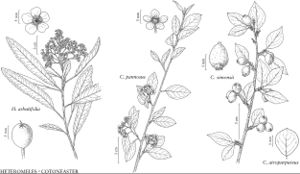Cotoneaster simonsii
in W. W. Saunders, Refug. Bot. 1: plate 55. 1869.
Shrubs, 2–4 (–6) m; ± strict or ascending, crown narrow or ± columnar. Stems erect, stiff; branches spiraled, divaricate, lateral branches ± straight, mostly suppressed, short, grayish brown, initially densely strigose. Leaves deciduous (sometimes tardily so on vigorous sprouts); petiole 3–5 mm, strigose; blade on vigorous shoots broadly elliptic to ovate, sometimes elliptic, rarely suborbiculate, 17–36 × 10–25 mm, chartaceous or subcoriaceous, base obtuse or cuneate, margins flat, veins 4 or 5, superficial or slightly sunken, apex acuminate or acute, abaxial surfaces light green, initially strigose, usually becoming sparsely so, adaxial green to dark green, shiny, not glaucous, flat or faintly bulging between lateral-veins, or slightly rugose, sparsely strigose; fall leaves yellow to bright orange or fiery red. Inflorescences on fertile shoots 15–30 mm with 4 leaves, 2–6-flowered, compact. Pedicels 2–5 mm, strigose. Flowers pendent, (5–) 8–10 mm, open; hypanthium campanulate, strigose; sepals: margins villous, borders narrow, glabrous, apex recurved, long acuminate or cuspidate, surfaces strigose; petals erect-incurved, dark red with white border; stamens 20, filaments pink, anthers white; styles (2 or) 3–5. Pomes bright orange to orange-red, usually obovoid, rarely cylindric or broadly obovoid, 7–14 × 6–10 mm, shiny, not glaucous, glabrous or sparsely villous; sepals erect or ascending, rarely nearly flat, margins villous, glabrous or sparsely villous; navel open; style remnants 2/3 from base. Pyrenes (2 or) 3–5.
Phenology: Flowering May–Jun; fruiting Oct–Apr.
Habitat: Shores, clearings, disturbed or open forests, thickets
Elevation: 0–200 m
Distribution

Introduced; B.C., Calif., Oreg., Tenn., Wash., Asia (Bhutan), Asia (India), also in Europe, Pacific Islands (New Zealand)
Discussion
Reports of Cotoneaster simonsii from Ohio (M. A. Vincent and A. W. Cusick 1998; T. S. Cooperrider et al. 2001) are here referred to C. divaricatus. The binomial C. symondsii T. Moore was proposed as an earlier name for C. simonsii (A. Kumar and G. Panigrahi 1992; W. B. Dickoré and G. Kasperek 2010), but J. Fryer and P. F. Zika (2014) typified C. symondsii so that it is a synonym of the high Himalayan species C. marginatus Lindley ex Loudon.
Selected References
None.
Lower Taxa
"thin" is not a number.
